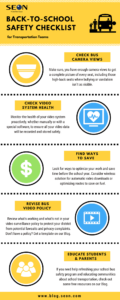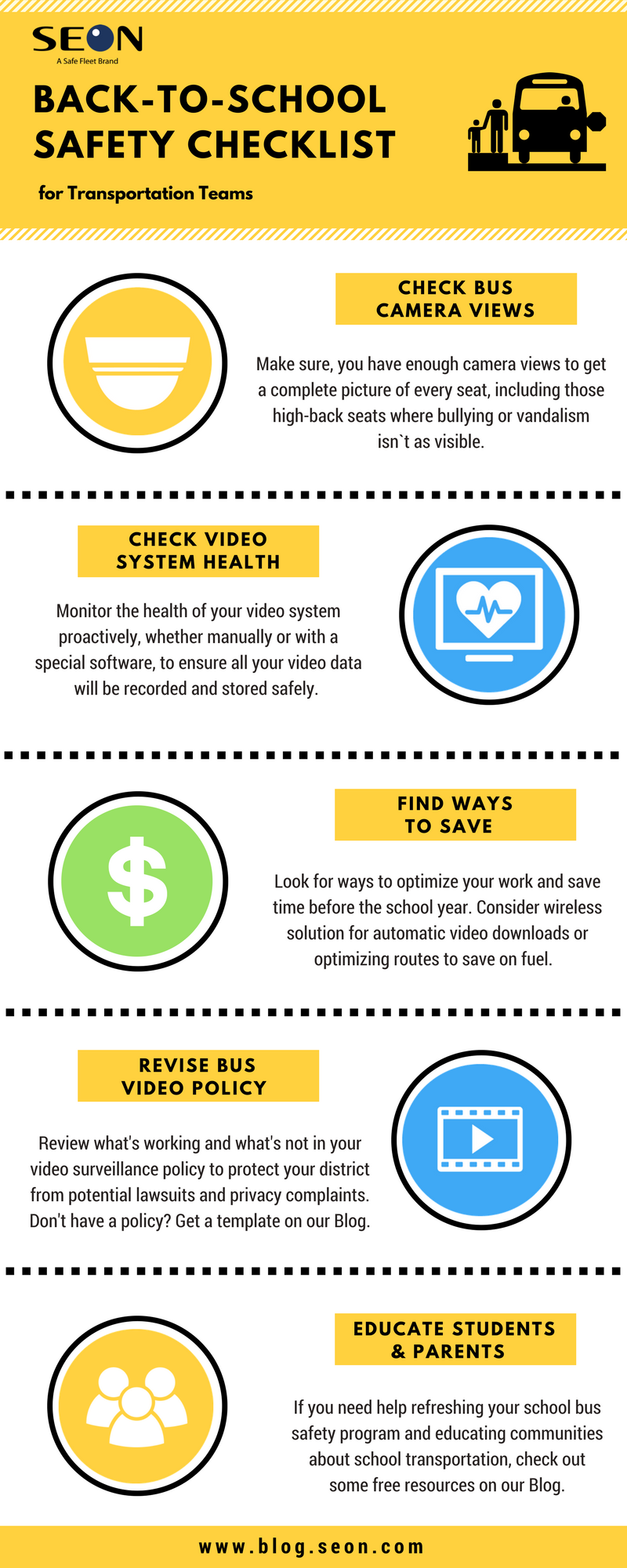Are you safety-ready for the new school year? The end of August and the start of September are quite a hectic time for transportation departments and school administration. Summer vacation time take us out of our normal operation schedules, so a quick reminder of important safety precautions is always a good idea.
To help you stay on top of things, we’ve made a back to school checklist for school transportation teams with links to resources to ensure fleet safety is under control:
- Check bus camera views.
 Camera placement on the bus is essential when it comes to accident reconstruction and complaint investigation.
Camera placement on the bus is essential when it comes to accident reconstruction and complaint investigation.
The National Transportation Safety Board (NTSB) has investigated many highway accidents where onboard video systems recorded critical crash-related information. In their safety report they recommend that on-board video systems should provide the following views to transportation teams:
- Visibility of the driver and of each occupant seating location
- Visibility of the forward of the vehicle
- Optimized frame rate, and low-light recording capability
It’s hard to provide visibility on the bus with less than four cameras on board. In some cases, you might need to reposition your cameras, for example, arrange them in a cross-view or ‘zigzag’ pattern to get more clarity on what`s happening between the seats. Make sure, you have enough camera views to get a complete picture of every seat, including those high-back seats where bullying or vandalism isn`t as visible.
- Check the health of your video surveillance system.
Once you finished preventive maintenance of your fleet vehicles, we highly recommend checking the health of your bus video system. It will help you ensure all your video recorders are working properly and that the camera footage will be safely stored and easily accessible when you need it.
If you have a video management software with wireless downloads, you will be able to monitor the health status of your video surveillance systems directly from your office by scheduling automatic video downloads from the bus.
Another option is to ask your drivers to check that the DVRs are working and that the cameras have no obstructions in front of them.
Next, make sure that the time is correct on the DVR. Unless you have a GPS unit connected to the DVR, time can tend to drift by several minutes over the course of a year. GPS will synchronize the accurate time and eliminate this step. Finally, do a camera view test.
If one of your system components fails, think about hardware upgrades. Very often, aging systems equal more maintenance time and money.
To read more about ways to increase the life of your existing video system, check out this blog post.
- Find ways to save time and resources.
Once the school year starts, you’ll be too busy to re-organize and make changes in your everyday operations. Look for ways to optimize your work and save time before.
For example, if you still go to the bus to remove the hard drive with the recorded bus video, think about investing in wireless solution with automatic video downloads. For example, McAllen Independent School District saves a lot of time and resources with wireless downloading during busy seasons and their team is able to respond to requests and incident investigations much faster. Frisco ISD also benefits from wireless since it makes it easier to access recorded data from different remote locations if required.
Another way to save time is to check whether your routes are efficient. The less time it takes vehicles to travel from point A to point B, the more money the transportation team saves on fuel while reducing greenhouse gas emissions. To optimize logistics, you might need to have integrated vehicle and video surveillance data showing every school bus with its speed, direction, idling, and stops on a simple map layout. The best tracking and routing systems will offer a real-time view of your fleet operations with multiple options to adjust the routes according to your district’s needs.
- Revise your bus surveillance policy.
To protect your school district from potential lawsuits and privacy complaints, each transportation department needs a well-defined bus surveillance policy. If you haven’t reviewed your policy in a while, now it’s time to check whether it worked for your team in the past year or whether you need to make any changes.
Make sure your policy clearly states who can access the recorded footage and under which circumstances, what’s the purpose of the recording, and how student privacy rights are protected. It will help protect the reputation of your department and school administration in cases of parent complaints or lawsuits.
If you don’t have a surveillance policy in place, you can download a free template here.
- Review all resources to educate students and parents about school bus safety.
If you need help refreshing your school bus safety program and educating communities about school transportation, we have some helpful links to free resources. Whether you need how-to guides, safety tips for parents and students, courses or templates, you can access our resource library here.
To help you prevent bullying on the school bus, we also created free resources on our United Against Bullying site. There you can find materials and inspiring stories to help organize your anti-bullying events and campaigns.
We hope this back-to-school checklist is helpful for your transportation team and we wish you a great school year ahead, safe and stress-free.
Want to help us improve safety in your transportation department? Call us at 1.877.630.7366 to speak with a representative in your area.
Vlada Terenina
Marketing Coordinator | Seon
vlada.terenina@seon.com



